Hello lovely Hiveans !
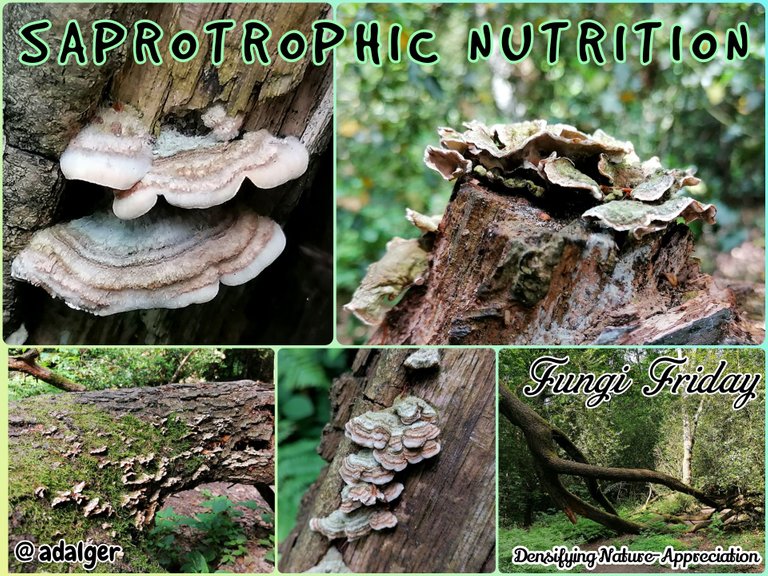
In my last post to the Fungi Lovers Community I wrote a bit about the Coprinellus Micaceus, also knows as the Mica Cap. This fungi is know for his "SAPROTROPHIC NUTRITION". This way of nutrition is actually such a really cool feature of fungi that I decided to dedicate my new post to this topic. Thus, as I needed some nice pictures to accompany my post, I went into the nearby forest a while ago, during June to be exact, and took some pictures of two different Saprotrophic Fungi species ^^
1) What is Saprotrophic Nutrition ?
First of all, I like to provide you with a quick explanation. In general, Saprotrophic Nutrition refers to the process of the prior digestion and then the subsequent processing of dead organic matter by other organisms, such as Saprotrophic Fungi or bacteria. In fact, these kind of nutrition is mainly done by fungi and being capable to do so grants them the amazing position as key regulators in nutrient recycling and in nutrient distribution in a vast range of terrestrial ecosystems. During my write-up I will get back to the digestion in more detail, but first I like to start with my visual tour from the forest ^^
2) Dead Trees as Source of Organic Matter !
A really good source of organic matter for Saprotrophic Fungi that can be found in all forests are dead trees. I know from my countless visits to my close-by forest that it has quite a lot of fallen trees, so I used these to investigated and to search for them. In the first picture you can see two trees that I found directly next to each other and that I examined separately.
 Dead trees are an excellent source of organic matter for the digestion and subsequent procession by Saprotrophic Fungi.
Dead trees are an excellent source of organic matter for the digestion and subsequent procession by Saprotrophic Fungi.
After a quick look the first tree seemed to have no fungi at all on its surface, but only an interesting grated looking bark. A closer look into the bark structure then revealed that there were little fungi located all over the surface in-between the bark. But their color and shape grants them a good camouflage look ;)
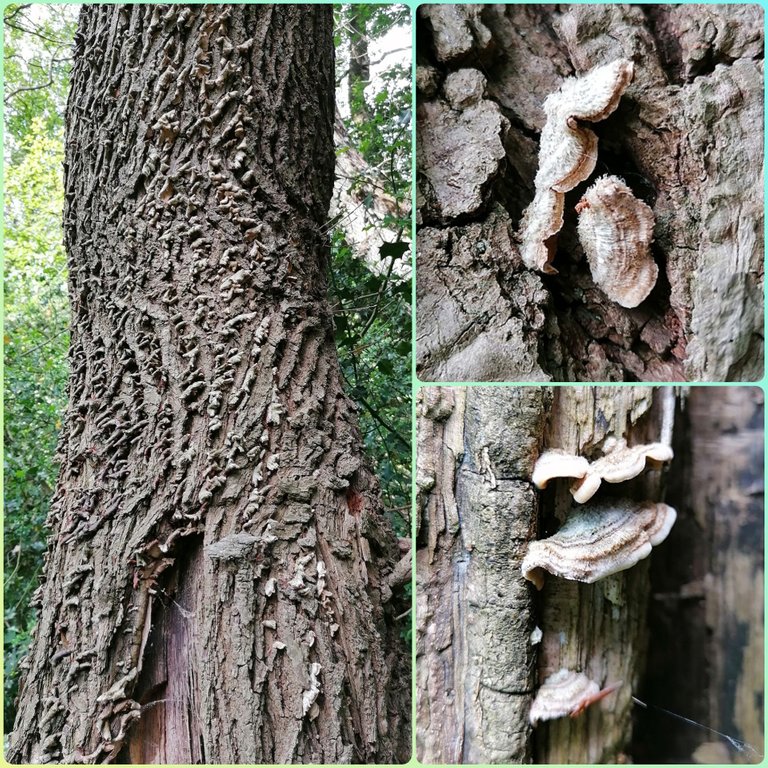 The dead tree has Saprotrophic Fungi located in-between its grated bark.
The dead tree has Saprotrophic Fungi located in-between its grated bark.
The part of the stem that was located directly above the ground and was already free of bark then revealed some really nice clusters of fungi. Especially the fallen thick branches that were found around the tree on the ground showed big clusters of them.
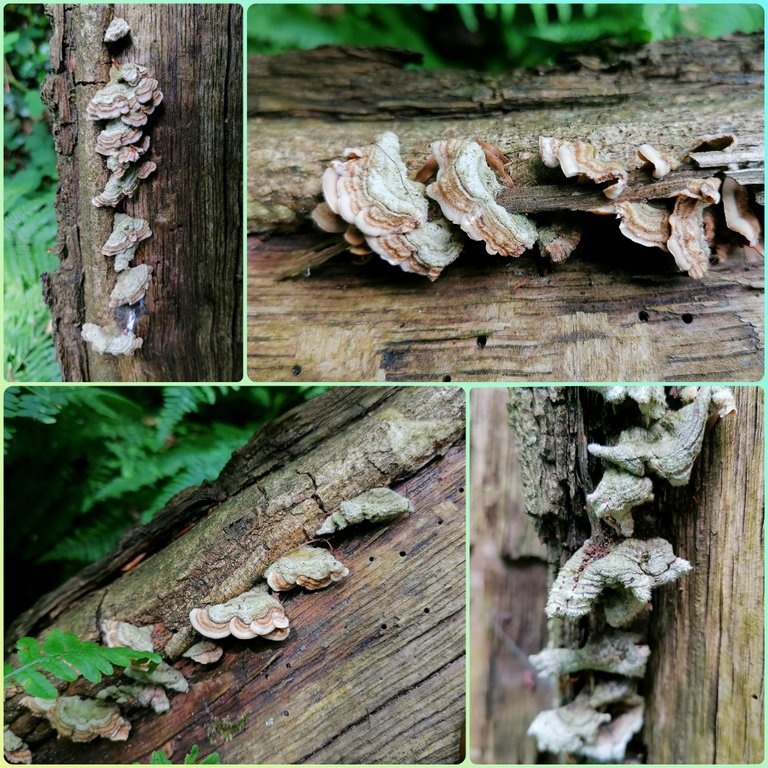 The stem close to the ground and the fallen branches show big clusters of Saprotrophic Fungi.
The stem close to the ground and the fallen branches show big clusters of Saprotrophic Fungi.
The second tree did not have any bark left on its stem and was already a bit more rotten then the first one. Here there were already far more fungi present from the beginning. Especially the fracture points of the branches had some really big clusters on them.
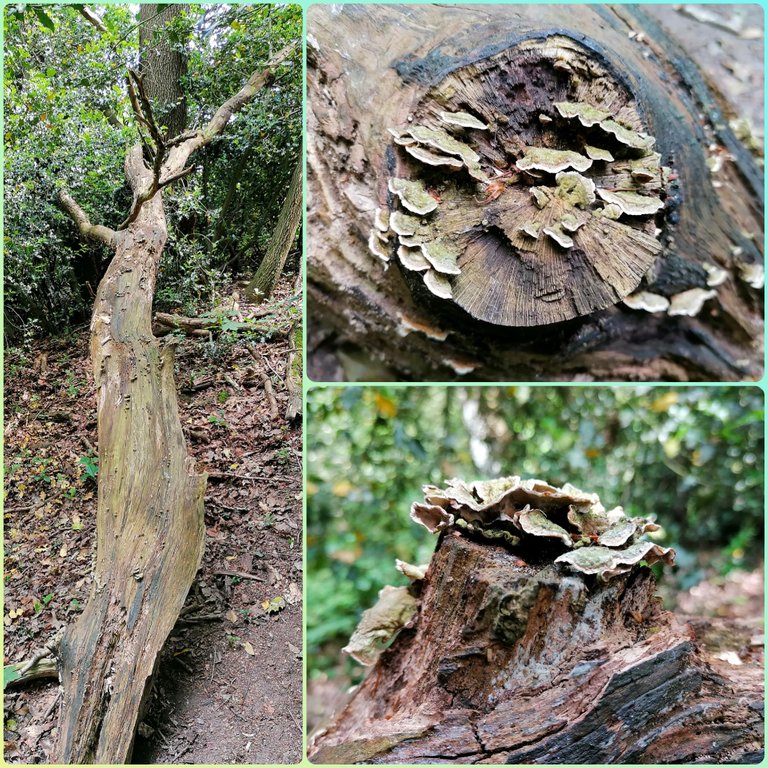 The fracture points of the branches have some really big clusters of Saprotrophic Fungi.
The fracture points of the branches have some really big clusters of Saprotrophic Fungi.
The fungi on this tree, also they were very similar to the ones at the first tree, are a different species. It was also interesting that by looking at the trees again, I found that each of them only features one of these fungi species and they did not mix up.
 The stem has no bark left, is more rotten and bears more Saprotrophic Fungi from the beginning.
The stem has no bark left, is more rotten and bears more Saprotrophic Fungi from the beginning.
3) The Decomposition of Organic Matter into Smaller Compounds :
Basically there are 3 major components from which all organic matter consists. I assume that you all know them already by name, as it is quite common knowledge, but in the further write-up I will get into the details behind them. These are:
- 1 ) Proteins
- 2 ) Lipids
- 3 ) Carbohydrates
The actual process of the "Saprotrophic Nutrition" is the digestion and thus decomposition of these 3 components into its smaller elementary compounds. These compounds can then be used by the fungi to build their own ones components or can be delivered back to the ecosystem around them. Thus, you may consider the "Saprotrophic Nutrition" as a super effective way of bio-recycling. In the following I like to explain these components a little bit, so that you have a crude overview about what they are, what they are made of, and which purpose they have in living organic matter.
1 ) Proteins (Polymeric Amino Acids)
Proteins, sometimes referred to as Enzymes take over a vast range of functions in each living being. You may consider them as the programs or the codes which run a whole living system. They execute all the tasks that are necessary to run a living system. Proteins are basically very very long chains of chain-linked amino acids and their length differ from 100 to 10.000 amino acids! .. There are 21 common amino acids that are common around all life forms on earth and therefore one can imagine, that there are also countless possible protein confirmation possible ! .. These amino acids all posses the exact same structured main chain and a different and variable side chain. In each protein structure theses amino acids are linked along their main chains. But as the whole protein possesses a big collection of side chains too, which are all different in each amino acid, the resulting 3D structure of each protein is completely different in the end. This also effects its function too.
2 ) Lipids (Polymeric Fatty Acids)
Compared to Proteins, Lipids only posses a small range of functions, which you can easily count by just your two hands. Their 2 main functions are the formation of cell walls and membranes in all biological systems and the energy storage within these. Thus the are forming the huge cell spaces in which all other proteins/enzymes can take over their designated work, Also there are some different types, lipids mainly consist of 3 long fatty acids chains, in all kind of variations, that are connected via a glycerol molecule as a linker.
3 ) Carbohydrates (Polymeric Saccharides)
Carbohydrates, also referred to as Saccharides or Sugar, also posses only a small range of functions. While Lipids are used for energy storage, Saccharides are directly used as a easy accessible energy source. Sacharides basically consist of a chain from 5 to 7 carbon atoms with several -OH moieties attached to that chain. Depending on their exact configuration they are named different, such as Glucose or Fructose. Di-saccharides, made from 2 linked mono-saccharides are also possible, such as Lactose or Maltose. There are really a lot of different types of sugar. By the way, the food industry is really good in listing them separately on food packages to confuse and fraud consumers. But the most important saccharides for saprotrophic fungi are the poly-saccharides, which consist of many linked saccharides, such as Stach and Cellulose. Cellulose is found up to 50 % in plant cells, and thus the major resource of dead wood and main nutrition for saprotrophic fungi.
4) The Two Saprotrophic Fungi that I Discovered !
I mentioned already that I discovered two different species of Saprotrophic Fungi on the trees. With the help of @qwerry, the the community leader if the Fungi Lovers Community, a long-time DNA fellow and my Nr.1 address whenever it comes to fungi, they could be identified as Trametes Versicolor (left) and a Trametes Pubescens (right). Both are from the genus of Tremetes.
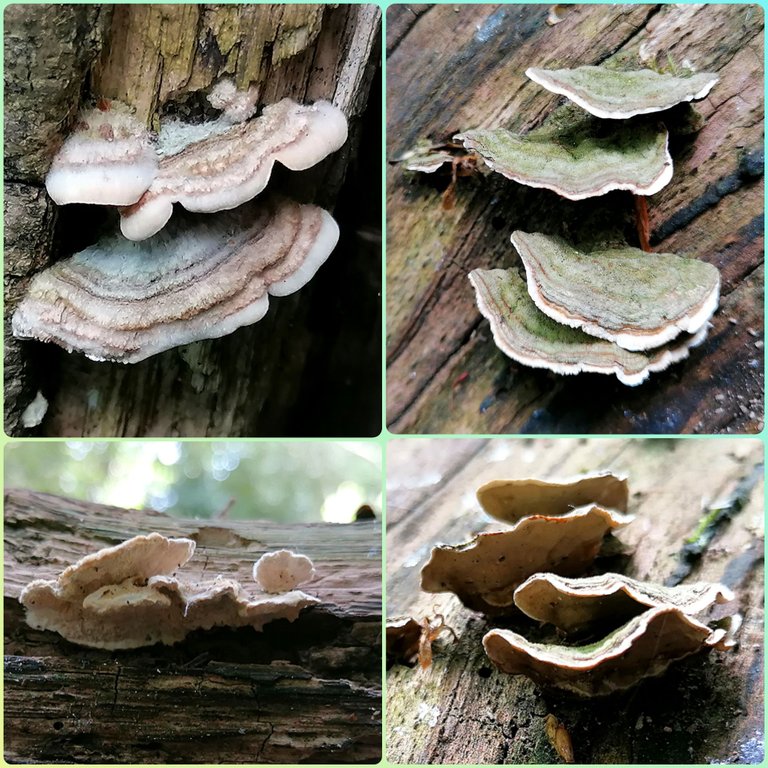
The Trametes Versicolor (left) and a Trametes Pubescens (right) are two common Saprotrophic Fungi.
1 ) Trametes Versicolor (left)
The Trametes Versicolor is known for its cosmopolitan distribution, which means that he can be found just everywhere on earth from May to August. He is a really common fungi that mainly grows in rows at red beech, but also on oak, birch, hazel and willow trees. Thereby his favored places are the stump and lying branches, which is also where I mainly detected them during my fungi hunt. The cap of the fungi, as you can see on the pictures, are having several concentric zones with different colors in each of them. It is flat, around up to 8 cm (broad) and 5 cm (deep) in diameter and a thickness of 1 cm. This fungi is not edible. [Source]
2 ) Trametes Pubescens (right)
The Trametes Pubescens can be also found in a wide range of countries and is common throughout Asia, America and Europe. Contrary to the Trametes Versicolor he prefers to grow in clusters rather than in rows as you can see on the pictures. In addition their caps now feature sharper outer edges. But they can grow to the same approximate size and have a similar, but far less distinctive concentric color zone pattern. [Source]
5) Saprotrophic Fungi and Moss - Both love Water ^^
For the end of my post I like to show some other fallen trees and their Saprotrophic Fungi to you that caught my attention. These trees also had some fungi on them and they were always growing on the side where I could also find all the attached moss. Moss is known to grow on the shady sides of trees. They really like to avoid the open sun and prefer water and moisture. This is actually also true for Saprotrophic Fungi. These are dependent on a lot of water too, so that it was not surprising that they were growing alongside the mossy parts of these trees too.
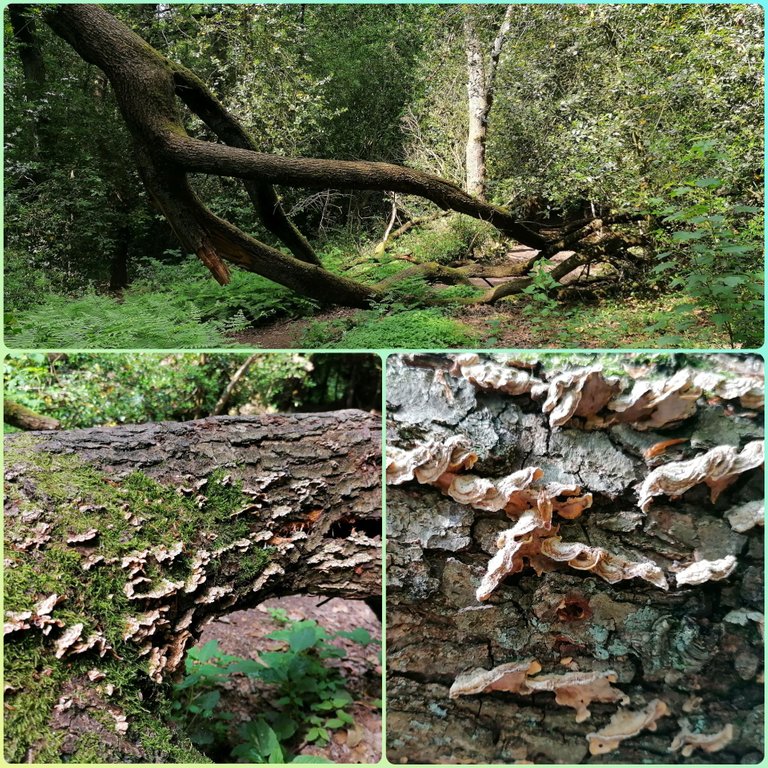
Saprotrophic Fungi need a lot of water and prefer to avoid the direct sun. They often grow alongside with moss.
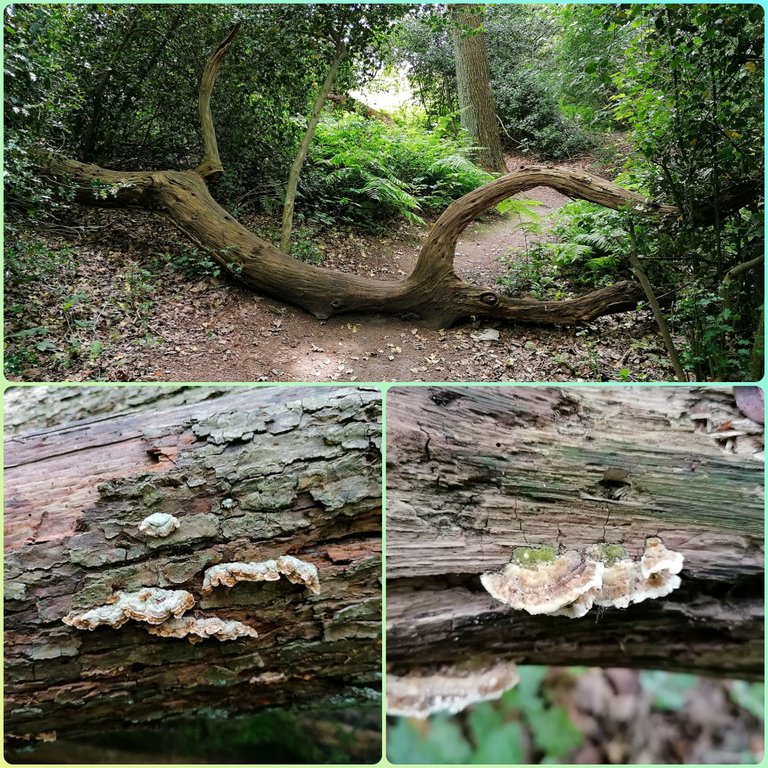
Thank you !
I hope that you enjoyed today's post about Saprotrophic Nutrition. I really liked to write this post already since my last #FungiFriday post which was a characterization of the Coprinellus Micaceus, another cosmopolitan Saprotrophic Fungi .. As I had a shoulder operation about a month ago, and have it still fixed together with my arm, it took me quite a while to get this post done. I had to do it one-handed which was a really weird and difficult challenge, but I actually had a lot of fun in the process and learned a lot new things about human motor control, haha .. I wish you all a great time out there in nature, stay safe and take care ^^
All pictures were taken by myself, ©@adalger, with a Huawei P30 Mobile Phone in June 2021. For information gathering I used a paper about Functional and Ecological Consequences of Saprotrophic Fungus by T. W. Crowther, L. Boddy and T. Hefin Jones from 2012 and the Wikipedia articles about Saprotrophic Nutrition, the Trametes Versicolor and the Trametes Pubescens.
 Clickable Banner that redirects to the Community ^^
Clickable Banner that redirects to the Community ^^ Clickable Banner that redirects to the Community ^^
Clickable Banner that redirects to the Community ^^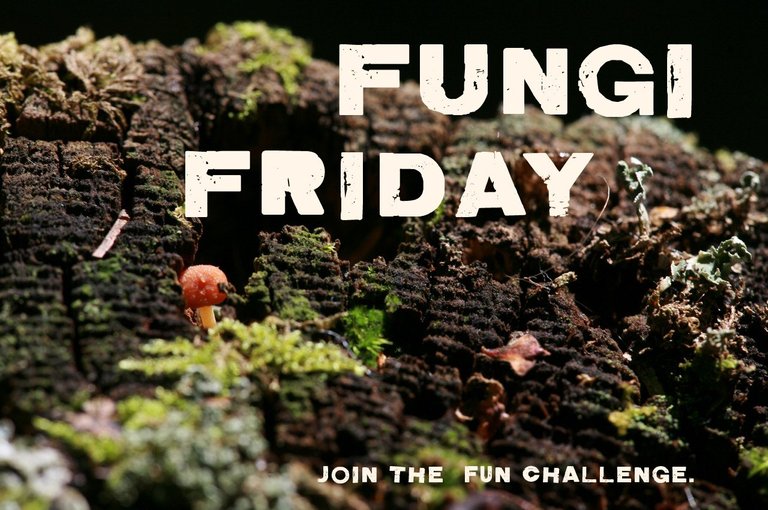 Clickable Banner that redirects to the Community ^^
Clickable Banner that redirects to the Community ^^
Clickable Banner that redirects to the DNA Discord server, the home of the nature communities on Hive ^^
 Clickable Banner that redirects to the Terminal Discord server ^^
Clickable Banner that redirects to the Terminal Discord server ^^If you want to know more about me, just look up my Introduceyourself post or follow my blog ^^
Learn more about @adalger here !

Best wishes,
Adalger
Congratulations @adalger! You have completed the following achievement on the Hive blockchain and have been rewarded with new badge(s) :
Your next payout target is 11000 HP.
The unit is Hive Power equivalent because your rewards can be split into HP and HBD
You can view your badges on your board and compare yourself to others in the Ranking
If you no longer want to receive notifications, reply to this comment with the word
STOPCheck out the last post from @hivebuzz: